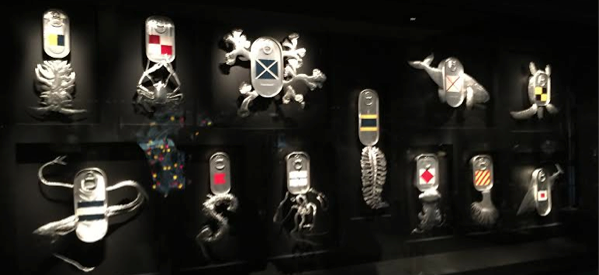Angel of History and the 56th Biennale
- Noa Ishaki
- Sep 25, 2015
- 4 min read

Highlights and thoughts on the 56th Biennale of Venice
In his interview in "Curating: Interviews with Ten International Curators" (pp. 48-57) which Okwui Enwezor gave in 2003 just after having curated dOCUMENTA XI, states that it is important that when curating an exhibition you are telling a story; and that there are many layers involved and that not everybody can understand it. Obviously it is not sufficient to just choose the artwork but create a theme and a flow from object to object. He worked as a team and had everybody more involved than would be expected while curating dOCUMENTA XI, he was led by the artwork itself, specifically the vision of the artist for presenting the works. He says, "they always kept in mind how works unfolded and flowed into each other and how the use of space allowed the viewer's subjectivity to emerge beyond that of the curator and the artwork."
It is very interesting but I think he means to say that in a way art precedes the reality or rather the realization of the changes occurring elsewhere in the world. Artists are more aware of what's going on in the world and that artists and writers are "fully engaged in the social world". So in this case, in curating an exhibition, artists' vision and their work must be the guide. The curator has to take that into account but not manipulate the viewer either.
I liked Enwezor in this interview. I liked that he was democratic in the way he worked and that he respected the art more than his subjective idea of the art. And that curating is about telling a story.
On the other hand, Okwui Enwezor envisioned that the 56th Biennale is imagined through a layer of filters. His inspiration came from Walter Benjamin (1892-1940)’s interpretation of Paul Klee’s Angelus Novus, as he incorporated it in his theory of the “’angel of history,’ a melancholy view of historical process as an unceasing cycle of despair”.
“Angelus Novus depicts an angel looking as though he is about to move away from something he is contemplating fixedly. His eyes are staring, his mouth is open, and his wings are spread. This is how one pictures the angel of history, with his face turned toward the past” (Illuminations, ed. Hannah Arendt, trans. Harry Zohn [London, 1973], p. 259).

Highlights and Notes from the 56th Biennale of Venice
Hungary
Sustainable identities
Climate change, left without air, inflated balls
Serbia
United Dead Nations. Flags.
Greece
Are we to return to living as a loner in the wilderness?
Brazil
Favelas, living on the outskirts, prisons, urban and architectural imprisonment.
Australia
Fiona Hall’s All the Wrong Turns is just like a mini-museum exhibition. While many have found it to be too crowded I loved that all sections weaved a story of global politics, finances and the environment as it seems was the intention of Hall. From the display of the sardine can sculptures and fossils to the use of camouflage garments and clocks, the first exhibition held in the new Australian Pavilion was one of my favorites.


Norway
Camille Norment’s Rapture included installations made of panes of broken glass and speakers that looked like microphones. It makes you think you need to speak whereas you actually need to listen. Powerful!


Austria
Curated by Yilmaz Dziewior, the director of the Ludwig Museum in Cologne, Heimo Zobernig’s installation has been called empty by many. The black monolith suspension from the ceiling in the context of All the World’s Futures reminded me of this darkness hanging over which is reflected down in all emptiness. When I visited it there was a very strong burnt wood smell and with the emptiness and black surface it did make me think of the end of the days.
Venezuela
Freedom from toxic food, breastfeeding women.


Turkey
Sarkis' Respiro, curated by Defne Ayas, is about light, as in shedding light, and the main work is a distorted rainbow, a game of light, breaking of light. (When the great disaster/flood ends, isn’t it known from the appearance of the rainbow?) But this is an imperfect one of course given the history. The word Respiro means breath, which to me felt like we had to take a deep breath, breathe out –accept- and take your first breath into a new life.
Extremely meaningful since it is 100 years after 1915.

Read the Publication for more info.
Armenia
Curated by the fantastic Adelina Cüberyan von Fürstenberg, Armenity the winner the Golden Lion for Best National Pavilion of the 56th Biennale (2015) is located in the monastery and island of San Lazzaro degli Armeni, which is not easy to get to and I’m afraid was missed by many visitors because of this. The exhibition displays experiences of the Armenian diaspora and identity issues and makes one think of past, present and future massacres, exiles and matters of assimilation.
UK
Sarah Lucas.
A favorite of many of the biennale visitors –visually, and while was good in and of itself with its yellow large sculpture of a phallus and walls, at first I felt it didn’t fit in the general context of the biennale. But then I thought about the other sculptures, as topless women, literally without tops above the waist, which are perfect just as display mannequins. Yet they don’t have tops, or heads.
But then I loved it, because it came to me: Maybe, it stresses that the dominating male power, symbolized by the phallus, is ever-present and the increasing number of women who are about their bottoms but nothing above is what is more of in the future...




Comments